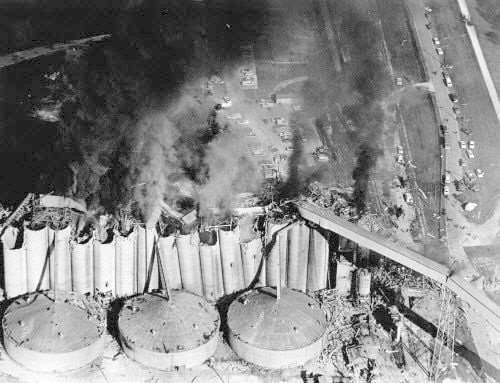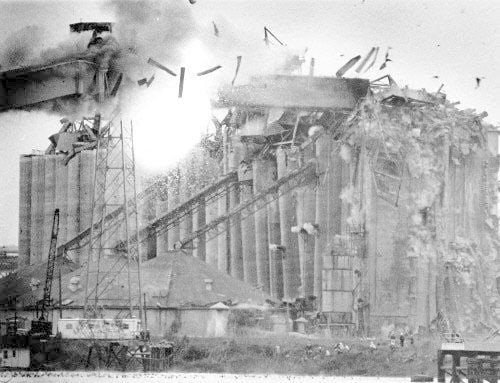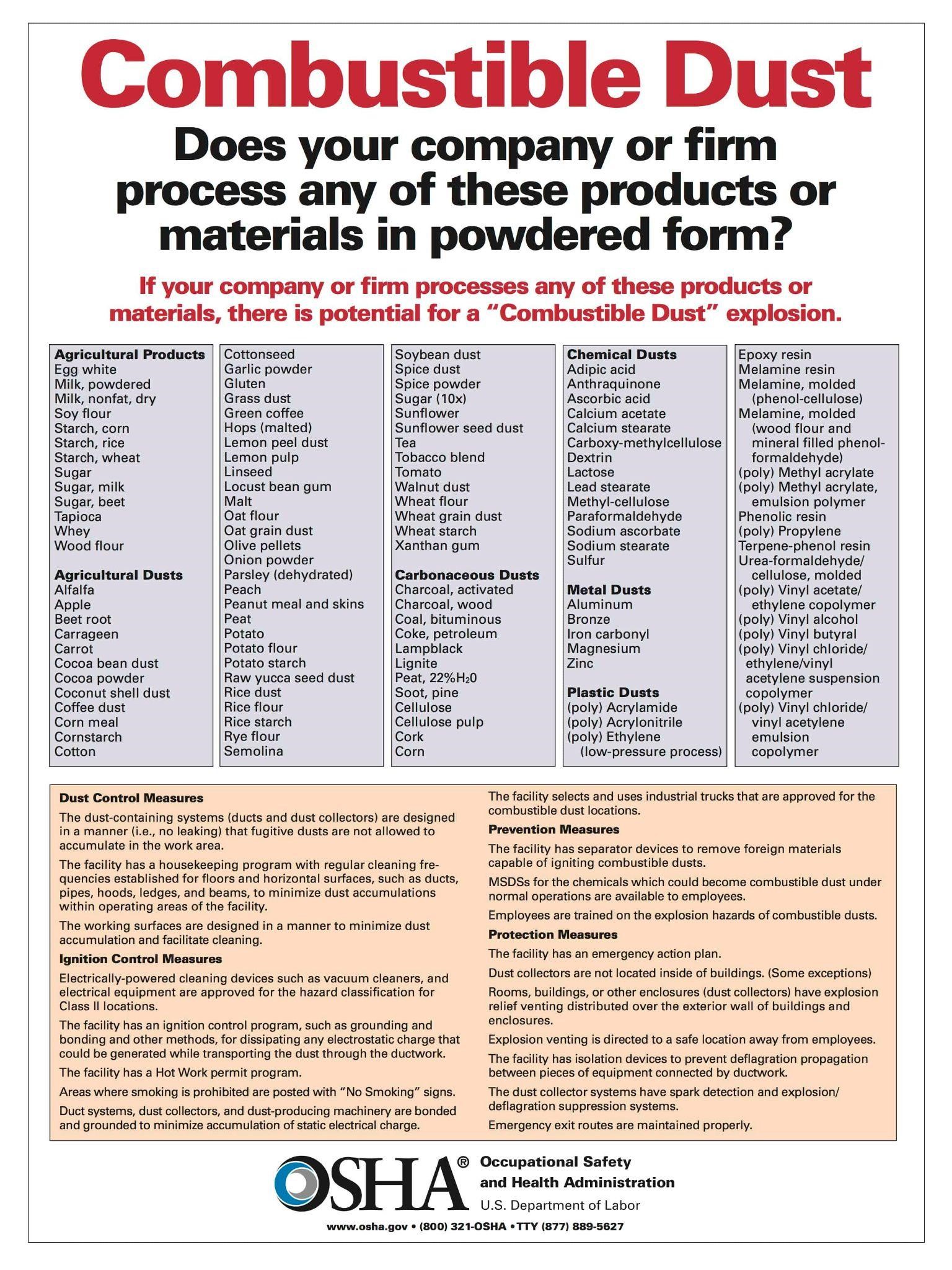Published September 9, 2024, Authored by Dr. Chris Cloney and Jon Barrett of Dust Safety Science

What Are Grain Dust Explosions?
Grain dust explosions are among the most catastrophic events in industrial history, often leading to significant loss of life, property damage, and economic disruption. One of the most notorious incidents in this category was the Continental Grain Elevator Dust Explosion. This tragic event not only underscored the devastating potential of combustible dust but also catalyzed substantial changes in industry standards and regulations.
Grain dust explosions occur when fine particles of dust become suspended in the air and ignite in an enclosed environment. These explosions are characterized by their rapid onset and immense destructive power. The primary factors contributing to these explosions include the combustible nature of grain dust, the presence of an ignition source, and the confinement of the dust cloud. The combination of these elements can lead to a sudden and violent explosion, capable of causing widespread destruction.
Dust accumulation, particularly combustible dust, poses significant hazards that can lead to devastating explosions and fires. Understanding how to remove combustible dust from the air safely and effectively, is essential to protect workers, equipment, and the manufacturing facility.
Fine particles, such as combustible dust, can easily ignite and lead to dust explosions, which are often catastrophic. These combustible dust explosions occur when dust accumulates in a grain elevator and becomes airborne, creating a dust cloud that can be ignited by heat sources, such as machinery, electrical sources, sparks, friction, or static electricity.
The Continental Grain Elevator Dust Explosion
On December 22, 1977, the Continental Grain Company’s grain elevator, in the small town of Westwego, Louisiana, was the site of one of the deadliest grain dust explosions in U.S. history. The explosion resulted in the deaths of 36 people and caused extensive damage to the facility. The magnitude of the dust explosion was so severe that it was felt miles away, and the immediate effects were devastating. The grain elevator dust explosion not only shocked the industry but also served as a wake-up call, highlighting the urgent need for stricter safety standards and regulations.
Analysis of the Continental Grain Elevator Dust Explosion Sequence
The Continental Grain Elevator Dust Explosion unfolded in a matter of seconds, yet its impact was felt for years. The sequence began when grain dust, accumulated over time in the facility, and became suspended in the air. Investigators blamed the catastrophe on a random spark igniting grain dust, although the origin of the spark was never identified. Static electricity or machinery were two possible origins. This initial blast was followed by a series of secondary explosions, as more dust was dislodged and ignited. The chain reaction explosion caused the grain elevator to collapse, trapping workers inside and causing significant fatalities and injuries.

Several factors contributed to the Continental Dust Explosion:
- Grain Dust Properties: Grain dust is highly combustible, and when dispersed in the air, it forms an explosive mixture. The finer the particles, the more dangerous they become, as they can remain suspended in the air for longer periods.
- Environmental and Operational Conditions: The facility’s design, including confined spaces where dust could accumulate, and inadequate ventilation, increased the risk of an explosion. Additionally, operational practices, such as the lack of regular cleaning and maintenance, allowed dust to build up to dangerous levels.
Immediate Responses and Emergency Actions Taken
In the immediate aftermath of the grain elevator explosion, emergency response teams were dispatched to the site to search for survivors and contain the fire. The extent of the damage, however, made rescue efforts challenging. The incident prompted an investigation by the federal government, and several federal agencies, including the Occupational Safety and Health Administration (OSHA) and the National Fire Protection Association (NFPA), to determine the cause and recommend safety regulations, safety measures, and improvements.
Impact on Industry Standards and Guidelines
Before the Continental grain elevator explosion occurred, industry standards for grain handling and storage were less stringent, with limited regulatory oversight. While some guidelines existed, they were often outdated and not rigorously enforced. The lack of comprehensive standards allowed hazardous conditions to persist, making facilities vulnerable to a dust explosion.
Re-Evaluation of Existing Standards
The Continental grain elevator dust explosion was a turning point, prompting a comprehensive reevaluation of existing safety standards with grain elevators. Industry leaders, regulatory bodies, and safety experts recognized the need for stricter regulations to prevent similar incidents. The explosion highlighted deficiencies in dust containment, equipment maintenance, and worker training, leading to a broader industry-wide reform.
New Regulations and Standards Introduced Post-Explosion
In the wake of the Continental explosion, several new regulations and standards were introduced to enhance safety in grain handling and storage facilities and grain elevators. Key changes included:
- Dust Control Measures: One of the most significant changes was the implementation of more rigorous dust containment measures. Facilities were required to improve ventilation systems, conduct regular cleaning to remove dust accumulations and install dust collection systems to prevent dust from becoming airborne.
- Monitoring and Maintenance Practices: The explosion underscored the importance of regular monitoring and maintenance of equipment and grain elevators. New standards required facilities to implement routine inspections of equipment, including electrical systems, to identify and address potential ignition sources. Maintenance practices were also enhanced to ensure dust did not accumulate in hazardous areas.
- Enhanced Training Requirements for Staff: Worker training became a focal point in the new regulations. Facilities were required to provide comprehensive training to employees on the risks associated with combustible dust and the proper procedures for handling and storing grain safely. This training aimed to ensure that workers were aware of the dangers and knew how to respond in an emergency.
Comparative Analysis and Similar Incidents Before and After the Continental Dust Explosion
The Continental explosion was not an isolated event. Similar grain elevator dust explosions had occurred before, such as the explosion at the DeBruce Grain Elevator in Wichita, Kansas, in 1958, and the explosion at the Texana Grain Elevator in Corpus Christi, Texas, in 1981. However, the scale of the Continental explosion and its impact on industry standards set it apart.
In the years following the Continental grain elevator explosion, several other grain dust explosions occurred, but with fewer fatalities and less damage, thanks to the new regulations and standards. For example, the explosion at the Bartlett Grain Company facility in Atchison, Kansas, in 2011, resulted in fewer casualties, indicating some success in preventing large-scale disasters.
Effectiveness of New Standards in Preventing Subsequent Explosions
The new standards introduced after the Continental grain elevator explosion have been largely effective in reducing the frequency and severity of a combustible dust explosion. According to OSHA and NFPA reports, the number of incidents decreased significantly in the years following the implementation of the new regulations.
The Federal Grain Inspection Service, (FGIS), a program within the USDA Agricultural Marketing Service, could cease weighing and inspecting grain at those facilities, in violation. All official agencies are strictly guided by the United States Grain Standards Act. This ensures consistency of test results and services, from elevator to elevator, and State to State. Official inspections of grains, oilseeds, and other agricultural and processed commodities are based on established standards, and sound, proven, and standardized procedures, techniques, and equipment. Facilities in the grain industry that adhered to the new standards experienced fewer explosions, and when explosions did occur, they were generally less destructive.
However, the effectiveness of these standards has not been universal. Some facilities, particularly smaller operations with limited resources, have struggled to comply fully with the new regulations. As a result, explosions continue to occur, though less frequently and with reduced impact.
Lessons Learned for Other Industries Handling Combustible Materials
The lessons learned from the Continental grain dust explosion extend beyond the grain industry. Other industries that handle combustible materials, such as coal mining, wood processing, and chemical manufacturing, have also benefited from the changes in safety standards. The principles of dust containment, preventing dust filled air, equipment maintenance, and worker training have been applied to these industries, helping to prevent future explosions and improve overall safety, for grain elevator employees.
Technology Advances, with the Integration of Artificial Intelligence, (AI), and Machine Learning, (ML), Preventing Explosions
Technological advancements integrating Artificial Intelligence (AI), the Internet of Things (IoT), and Machine Learning (ML) are revolutionizing the prevention of a dust explosion like the Continental Dust explosion disaster. IoT-enabled sensors placed throughout grain handling and storage facilities can continuously collect real-time data on key parameters such as dust concentration, air quality, equipment temperature, and humidity levels. AI systems analyze this data to detect patterns and anomalies that could signal rising dust levels or dangerous conditions. By leveraging ML algorithms, these systems can learn from historical data and improve their ability to predict potential explosion risks, allowing for timely interventions. For instance, when abnormal dust levels or when grain elevators are overheating is detected, AI-driven systems can trigger automatic adjustments in ventilation or initiate shutdowns to prevent ignition.
Moreover, the combination of AI, ML, and IoT technologies enhances predictive maintenance and operational efficiency. Smart technologies can monitor the health of equipment continuously, using machine learning to predict when machinery may fail or generate sparks. This proactive approach enables facilities to address maintenance needs before issues arise, significantly reducing the risk of dust igniting from malfunctioning equipment. These advanced systems can also be programmed to send alerts to operators, providing them with data-driven insights to take immediate action. The integration of AI, IoT, and ML not only improves safety in grain facilities but also enhances the precision and effectiveness of dust explosion prevention strategies across various industries handling combustible materials.

Conclusion
The Continental Grain Elevator Dust Explosion was a pivotal event in the history of industrial safety and the grain industry. It not only highlighted the dangers of dust but also prompted significant changes in industry standards and regulations. The impact of these changes has been far-reaching, improving safety in grain handling and storage facilities and influencing other industries that handle combustible materials.
Dust containment is an ongoing process with grain elevators and the grain industry. Regular maintenance, employee training, and staying informed about new technologies are essential for maintaining a safe and compliant workplace. By committing to these practices, you can create a safer work environment and protect your employees, equipment, and facility from the dangers of combustible dust.
About Dust Safety Science
Dr. Chris Cloney, of Dust Safety Science, provides additional information on Grains and Dust Explosions, with a Podcast. Click on the latest Podcast Links: Incident Update 2023 Grain Dust Explosion in Decatur, Illinois

Resources:
Visit: Fire and Explosion Protection Equipment Providers
Visit: Risk Assessment & Dust Hazard Analysis Providers
Visit: Combustible Dust Testing Providers
Visit Dust Safety Science (Global Incident Tracking)
Visit Dust Safety Academy (Resources, Training, and Events)
Visit Dust Safety Professionals (Need Help? Get Support Today!)
Visit Dust Safety Journal for the Dust Safety Science Monthly Journal
Subscribe to our FREE, Dust Safety Science Newsletter at Dust Safety Science Newsletter
Visit the Dust Safety Science blog for written articles on combustible dust safety including the latest research, expert opinions, and state-of-the-art fire and explosion protection.
